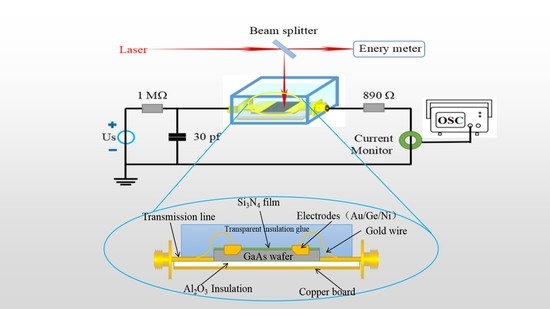Electrical Characterizations of 35-kV Semi-Insulating Gallium Arsenide Photoconductive Switch
Abstract
:1. Introduction
2. Materials and Methods
3. Results
4. Conclusions
Author Contributions
Funding
Institutional Review Board Statement
Informed Consent Statement
Data Availability Statement
Conflicts of Interest
References
- Chang, C.; Liu, G.; Tang, C.; Chen, C.; Fang, J. Review of recent theories and experiments for improving high-powermicrowave window breakdown thresholds. Phys. Plasmas 2011, 18, 055702. [Google Scholar] [CrossRef]
- Ajram, S.; Salmer, G. Ultrahigh frequency DC-to-DC converters using GaAs Power switches. IEEE Trans. Power Electron. 2011, 16, 594. [Google Scholar] [CrossRef]
- Hudgins, J.L.; Simin, G.S.; Santi, E.; Khan, M.A. An assessment of wide bandgap semiconductors for power devices. IEEE Trans. Power Electron. 2003, 18, 2644. [Google Scholar] [CrossRef] [Green Version]
- Stygar, W.A.; Cuneo, M.E.; Headley, D.I.; Ives, H.C.; Leeper, R.J.; Mazarakis, M.G.; Olson, C.L.; Porter, J.L.; Wagoner, T.C.; Woodworth, J.R. Architecture of petawatt-class Z-pinch accelerators. Phys. Rev. Accel. Beams 2007, 10, 30401. [Google Scholar] [CrossRef] [Green Version]
- Schoenbach, K.H.; Xiao, S.; Joshi, R.P.; Camp, J.T.; Heeren, T.; Kolb, J.F.; Beebe, S.J. The effect of intense subnanosecond electrical pulses on biological cells. IEEE Trans. Plasma. Sci. 2008, 36, 414. [Google Scholar] [CrossRef]
- Glover, S.F.; Zutavern, F.J.; Swalby, M.E.; Cich, M.J.; Loubriel, G.M.; Mar, A.; White, F.E. Pulsed-and DC-charged PCSS-based trigger generators. IEEE Trans. Plasma Sci. 2010, 38, 2701. [Google Scholar] [CrossRef]
- Pala, V.; Peng, H.; Wright, P.; Hella, M.M.; Chow, T.P. Integrated high-frequency power converters based on GaAs pHEMT: Technology characterization and design examples. IEEE Trans. Power Electron. 2012, 27, 2644. [Google Scholar] [CrossRef]
- Islam, N.E.; Schamiloglu, E.; Fleddermann, C.B. Characterization of a semi-insulating GaAs photoconductive semiconductor switch for ultrawide band high power microwave applications. Appl. Phys. Lett. 1998, 73, 1988. [Google Scholar] [CrossRef]
- Lee, C.H. Picosecond optoelectronic switching in GaAs. Appl. Phys. Lett. 1977, 30, 84. [Google Scholar] [CrossRef]
- Zutavern, F.J.; Loubriel, G.M.; O’Malley, M.W.; Shanwald, L.P.; Helgeson, W.D.; McLaughlin, D.L.; McKenzie, B.B. Photo-conductive semiconductor switch experiments for pulsed power applications. IEEE Trans. Electron Dev. 1990, 37, 2742. [Google Scholar] [CrossRef]
- El Amari, S.; Kenaan, M.; Merla, C.; Vergne, B.; Arnaud-Cormos, D.; Leveque, P.; Couderc, V. Kilovolt, nanosecond, and picosecond electric pulse shaping by using optoelectronic switching. IEEE Photon. Technol. Lett. 2010, 22, 1577–1579. [Google Scholar] [CrossRef]
- Shi, W.; Tian, L.; Liu, Z.; Zhang, L.; Zhang, Z. 30 kV and 3 kA semi-insulating GaAs photoconductive semiconductor switch. Appl. Phys. Lett. 2008, 92, 043511. [Google Scholar] [CrossRef]
- Nunnally, W.C.; Hammond, R.B. 80 MW photoconductor power switch. Appl. Phys. Lett. 1984, 44, 980. [Google Scholar] [CrossRef]
- Tian, L.; Shi, W. Multiple charge domains model for the lock-on effect in GaAs power photoconductive switches. J. Phys. D Appl. Phys. 2008, 41, 115107. [Google Scholar] [CrossRef]
- Xu, M.; Li, R.; Ma, C.; Shi, W. 1.23-ns pulsewidth of quenched high gain GaAs photoconductive semiconductor switch at 8-nJ excitation. IEEE Electron Device Lett. 2016, 37, 1147–1149. [Google Scholar] [CrossRef]
- El Amari, S.; De Angelis, A.; Arnaud-Cormos, D.; Couderc, V.; Leveque, P. Characterization of a linear photoconductive switch used in nanosecond pulsed electric field generator. IEEE Photon. Technol. Lett. 2011, 23, 673. [Google Scholar] [CrossRef]
- Zhao, F.; Islam, M.M.; Muzykov, P.; Bolotnikov, A.; Sudarshan, T.S. Optically activated 4H-SiC p-i-n diodes for high-power applications. IEEE Electron Device Lett. 2009, 30, 1182. [Google Scholar] [CrossRef]
- Kelkar, K.S.; Islam, N.E.; Fessler, C.M.; Nunnally, W.C. Silicon carbide photoconductive switch for high-power linear-mode opera-tions through sub-band-gap triggering. J. Appl. Phys. 2005, 98, 093102. [Google Scholar] [CrossRef]
- Dogan, S.; Teke, A.; Huang, D.; Morkoc, H. 4H-SiC photoconductive switching devices for use in high-power applications. Appl. Phys. Lett. 2003, 82, 3107. [Google Scholar] [CrossRef]
- Sullivan, J.S.; Stanley, J.R. 6H-SiC photoconductive switches triggered at below bandgap wavelengths. IEEE Trans. Dielectr. Electr. Insul. 2007, 14, 980. [Google Scholar] [CrossRef] [Green Version]
- Jiang, S.; Song, C.; Zhang, L.; Zhang, Y.; Huang, W.; Guo, H. Intrinsic photoconductive switches based on semi-insulator 4H-SiC. IEEE Trans. Electron Devices 2016, 63, 1582. [Google Scholar] [CrossRef]
- Han, W.-W.; Huang, W.; Zhuo, S.-Y.; Xin, J.; Liu, X.-C.; Shi, E.-W.; Zhang, Y.-F.; Cao, P.-H.; Wang, Y.-T.; Guo, H.; et al. A new method of accurately measuring photoconductive performance of 4H-SiC photoconductive switches. IEEE Electron. Device Lett. 2018, 40, 271. [Google Scholar] [CrossRef]
- Ma, C.; Shi, W.; Li, M.; Gui, H.; Wang, L.; Jiang, H.; Fu, Z.; Cao, J. Research on flashover characteristics and the physical mechanism of high-gain GaAs photoconductive switches. IEEE J. Quantum Electron. 2014, 50, 568–574. [Google Scholar] [CrossRef]
- Wang, S.; Shi, W. The role of the photo-generated carrier in surface flashover of the GaAs photoconductive semiconductor switch. IEEE J. Electron. Devices Soc. 2017, 6, 179. [Google Scholar] [CrossRef]
- Rosen, A. High-Power Optically Activated Solid-State Switches; Zutavern, F., Ed.; Artech House: Boston, MA, USA, 1994; p. 44. [Google Scholar]
- Xiao, L.; Hu, X.; Chen, X.; Peng, Y.; Yang, X.; Xu, X. Effect of periodic array on the on-state resistances of GaAs photoconductive semiconductor switch based on total reflection theory. AIP Adv. 2017, 7, 065119. [Google Scholar] [CrossRef] [Green Version]
- Shi, W.; Gui, H.; Zhang, L.; Ma, C.; Li, M.; Xu, M.; Wang, L. Effects of trigger laser pulse width on the jitter time of GaAs photoconductive semiconductor switch. Opt. Lett. 2013, 38, 2330–2332. [Google Scholar] [CrossRef]
- Shi, W.; Gui, H.-M.; Zhang, L.; Li, M.-X.; Ma, C.; Wang, L.-Y.; Jiang, H. Influence of the incident laser pulse energy on jitter time of GaAs photoconductive semiconductor switches. Opt. Lett. 2013, 38, 4339–4341. [Google Scholar] [CrossRef]
- Gaudet, J.A.; Skipper, M.C.; Abdalla, M.D.; Ahern, S.M.; Romero, S.P.; Mar, A.; Zutavern, F.J.; Loubriel, G.M.; O’Malley, M.W.; Helgeson, W.D. Temporal switching jitter in photoconductive switches. Proc. SPIE 2000, 4301, 121. [Google Scholar]
- Shi, W.; Zhang, L.; Gui, H.; Hou, L.; Xu, M.; Qu, G. Accurate measurement of the jitter time of GaAs photoconductive semiconductor switches triggered by a one-to-two optical fiber. Appl. Phys. Lett. 2013, 102, 154106. [Google Scholar] [CrossRef]
- Anderson, R.A.; Branard, J.P. Mechanism of pulsed surface flashover involving electron-stimulated desorption. J. Appl. Phys. 1980, 51, 1414. [Google Scholar] [CrossRef]
- Shi, W.; Ma, C.; Hou, L.; Xie, G.; Tian, L.; Wu, S. Velocity of current filament at the high gain mode of GaAs power photoconductive switches. Physica B 2011, 406, 3741. [Google Scholar] [CrossRef]
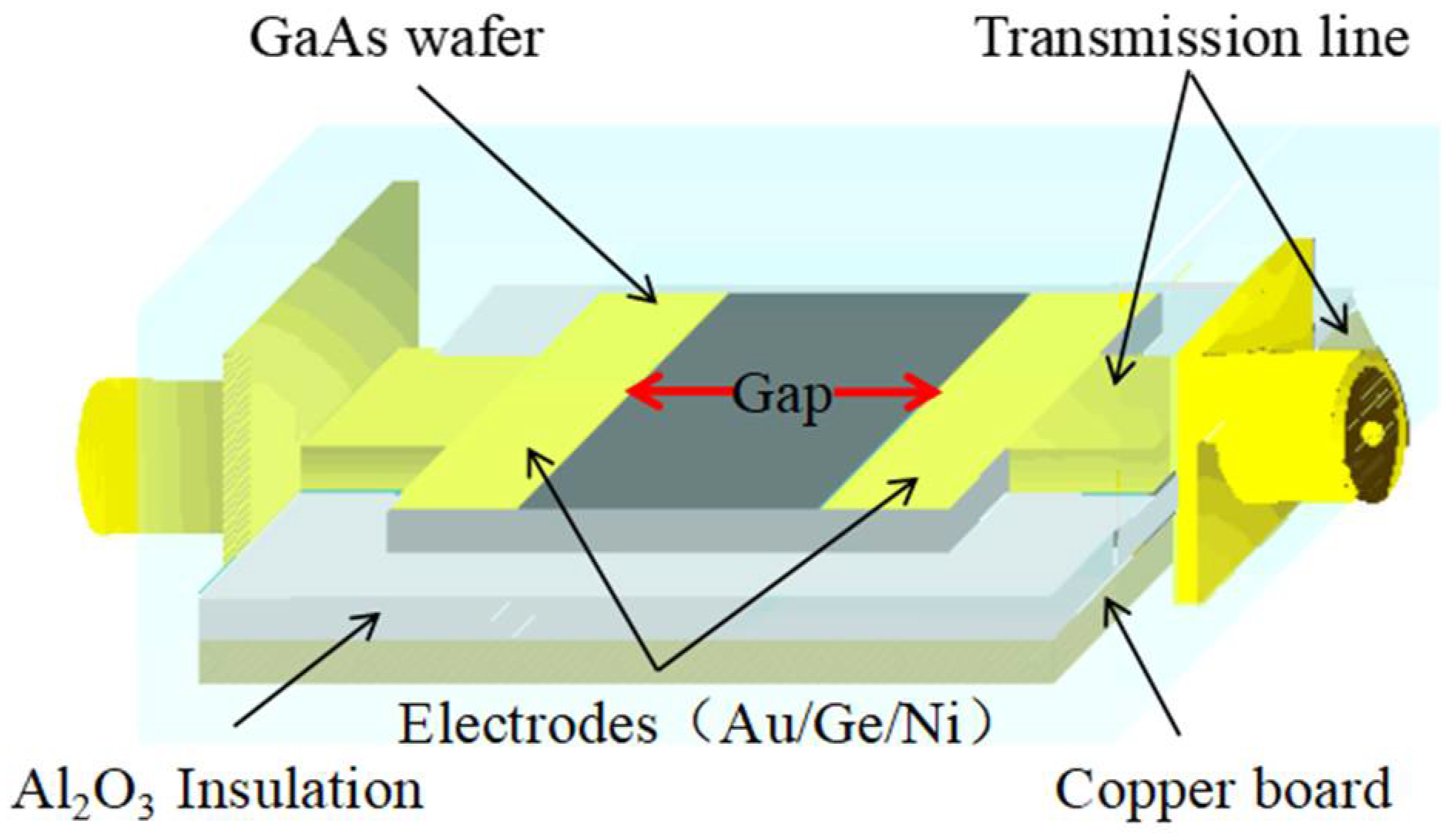

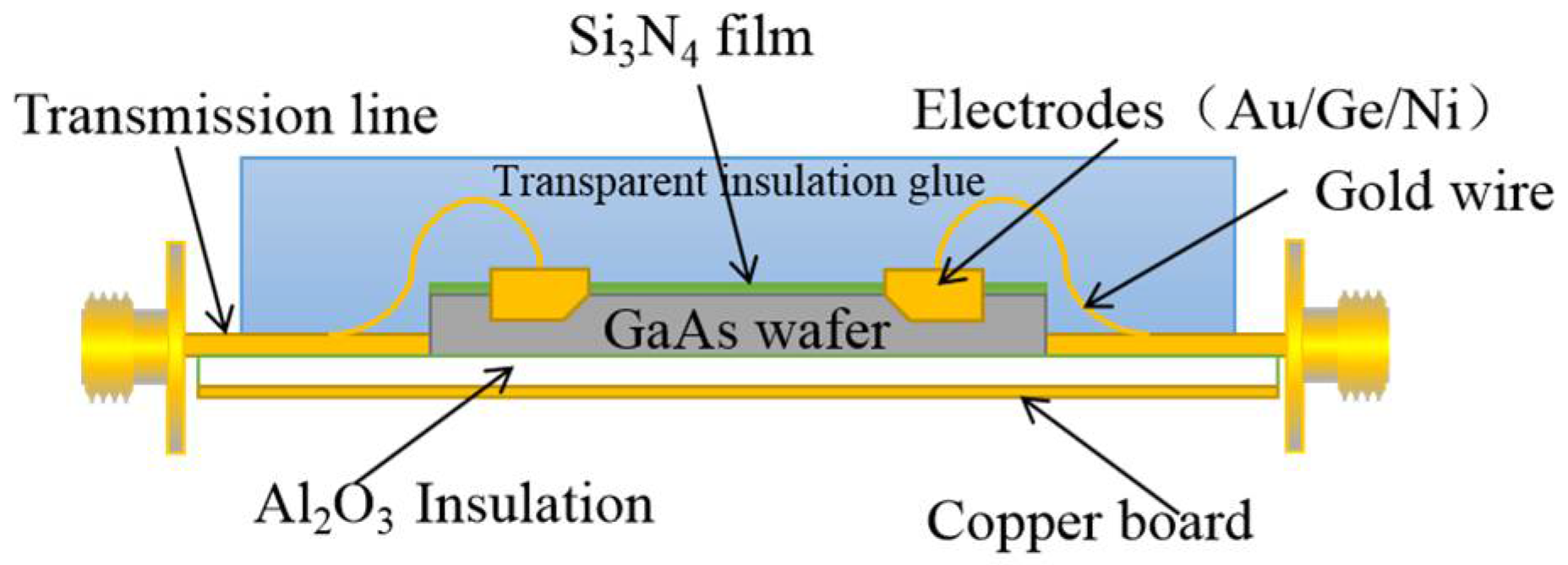

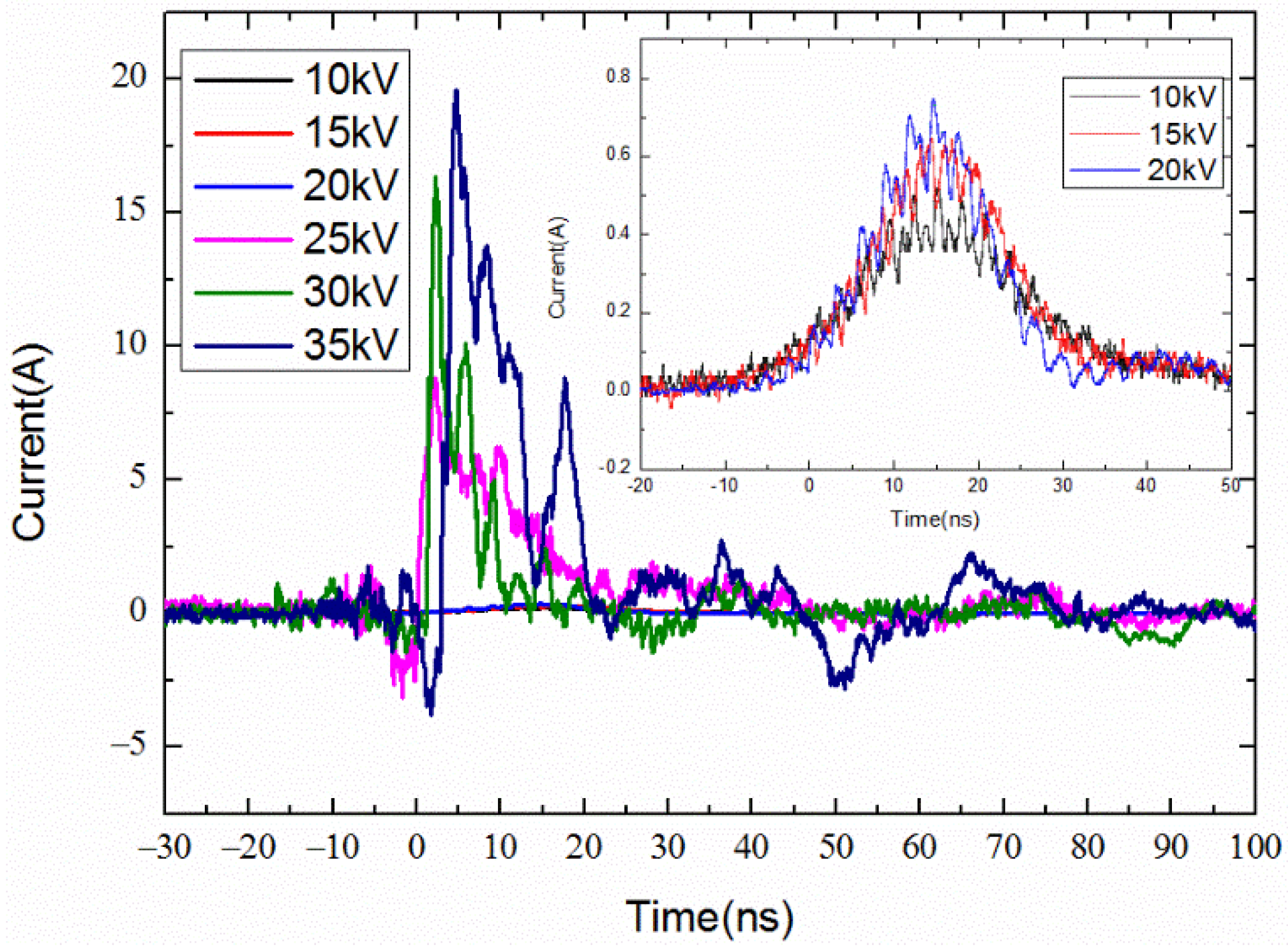

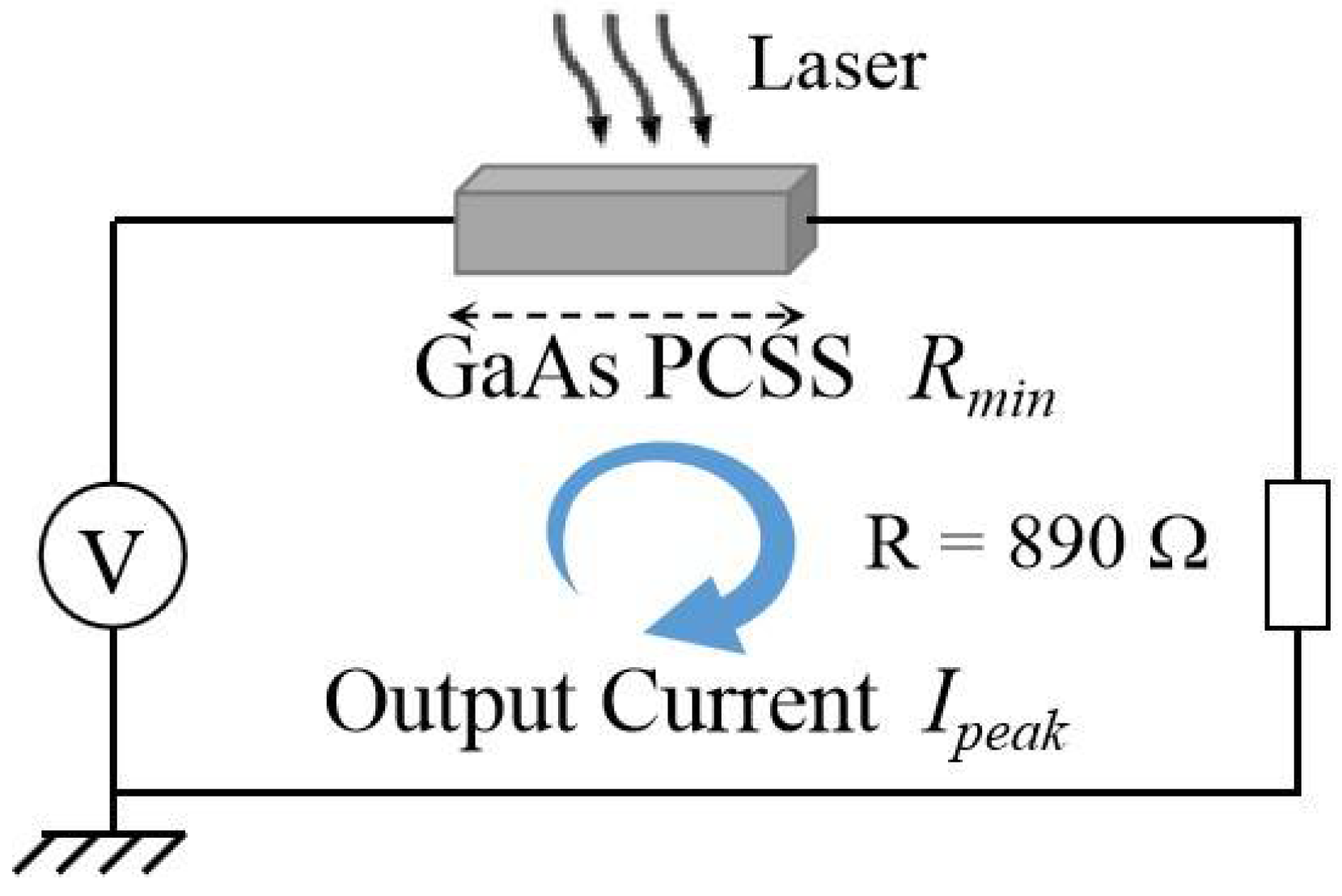


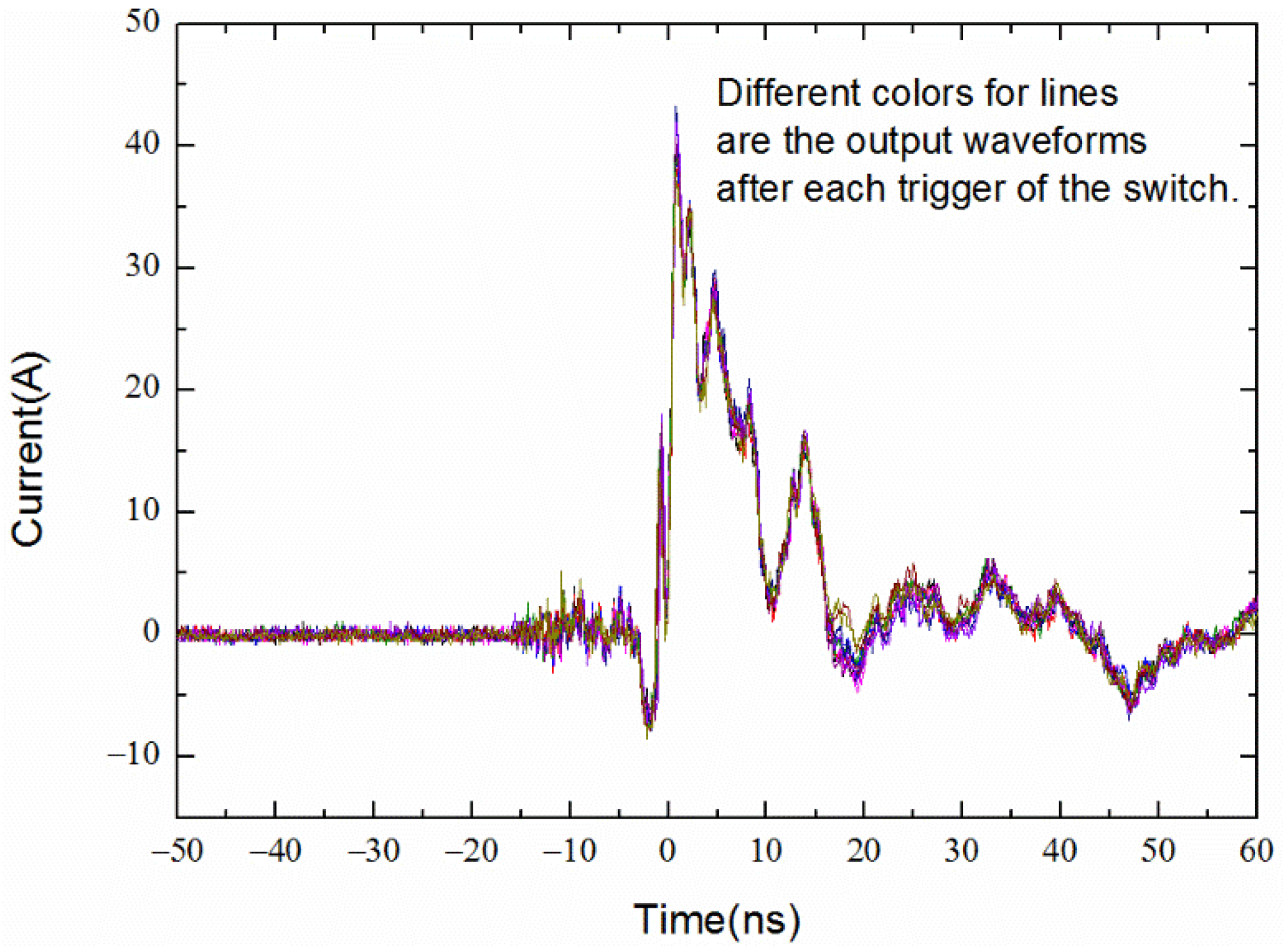

Publisher’s Note: MDPI stays neutral with regard to jurisdictional claims in published maps and institutional affiliations. |
© 2021 by the authors. Licensee MDPI, Basel, Switzerland. This article is an open access article distributed under the terms and conditions of the Creative Commons Attribution (CC BY) license (https://creativecommons.org/licenses/by/4.0/).
Share and Cite
Ma, C.; Wu, M.; Wang, W.; Jia, Y.; Shi, W. Electrical Characterizations of 35-kV Semi-Insulating Gallium Arsenide Photoconductive Switch. Photonics 2021, 8, 385. https://doi.org/10.3390/photonics8090385
Ma C, Wu M, Wang W, Jia Y, Shi W. Electrical Characterizations of 35-kV Semi-Insulating Gallium Arsenide Photoconductive Switch. Photonics. 2021; 8(9):385. https://doi.org/10.3390/photonics8090385
Chicago/Turabian StyleMa, Cheng, Meilin Wu, Wennan Wang, Yaqiong Jia, and Wei Shi. 2021. "Electrical Characterizations of 35-kV Semi-Insulating Gallium Arsenide Photoconductive Switch" Photonics 8, no. 9: 385. https://doi.org/10.3390/photonics8090385
APA StyleMa, C., Wu, M., Wang, W., Jia, Y., & Shi, W. (2021). Electrical Characterizations of 35-kV Semi-Insulating Gallium Arsenide Photoconductive Switch. Photonics, 8(9), 385. https://doi.org/10.3390/photonics8090385





